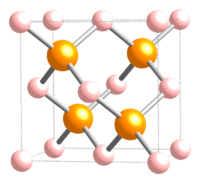Indium phosphide
 | |
 | |
| Names | |
|---|---|
| Other names
Indium(III) phosphide | |
| Identifiers | |
| 22398-80-7 | |
| 3D model (Jmol) | Interactive image |
| ChemSpider | 28914 |
| ECHA InfoCard | 100.040.856 |
| PubChem | 31170 |
| |
| |
| Properties | |
| InP | |
| Molar mass | 145.792 g/mol |
| Appearance | black cubic crystals |
| Density | 4.81 g/cm3, solid |
| Melting point | 1,062 °C (1,944 °F; 1,335 K) |
| Solubility | slightly soluble in acids[1] |
| Band gap | 1.344 eV (300 K; direct) |
| Electron mobility | 5400 cm2/(V·s) (300 K) |
| Thermal conductivity | 0.68 W/(cm·K) (300 K) |
| Refractive index (nD) |
3.1 (infrared); 3.55 (632.8 nm)[2] |
| Structure | |
| Zinc blende | |
| Tetrahedral | |
| Thermochemistry | |
| 45.4 J/(mol·K)[4] | |
| Std molar entropy (S |
59.8 J/(mol·K) |
| Std enthalpy of formation (ΔfH |
-88.7 kJ/mol |
| Hazards | |
| Main hazards | Toxic, hydrolysis to phosphine |
| Safety data sheet | External MSDS |
| Related compounds | |
| Other anions |
Indium nitride Indium arsenide Indium antimonide |
| Other cations |
Aluminium phosphide Gallium phosphide |
| Related compounds |
Indium gallium phosphide Aluminium gallium indium phosphide Gallium indium arsenide antimonide phosphide |
| Except where otherwise noted, data are given for materials in their standard state (at 25 °C [77 °F], 100 kPa). | |
| | |
| Infobox references | |
Indium phosphide (InP) is a binary semiconductor composed of indium and phosphorus. It has a face-centered cubic ("zincblende") crystal structure, identical to that of GaAs and most of the III-V semiconductors.
Manufacturing
.jpg)
Indium phosphide can be prepared from the reaction of white phosphorus and indium iodide at 400 °C.,[5] also by direct combination of the purified elements at high temperature and pressure, or by thermal decomposition of a mixture of a trialkyl indium compound and phosphine.[6]
Uses
InP is used in high-power and high-frequency electronics because of its superior electron velocity with respect to the more common semiconductors silicon and gallium arsenide.
It was used with indium gallium arsenide to make a record breaking pseudomorphic heterojunction bipolar transistor that could operate at 604 GHz.[7]
It also has a direct bandgap, making it useful for optoelectronics devices like laser diodes.
InP is also used as a substrate for epitaxial indium gallium arsenide based opto-electronic devices.
Chemistry
Indium phosphide also has one of the longest-lived optical phonons of any compound with the zincblende crystal structure.[8]
References
- ↑ Lide, David R. (1998), Handbook of Chemistry and Physics (87 ed.), Boca Raton, FL: CRC Press, pp. 4–61, ISBN 0-8493-0594-2
- ↑ Sheng Chao, Tien; Lee, Chung Len; Lei, Tan Fu (1993), "The refractive index of InP and its oxide measured by multiple-angle incident ellipsometry", Journal of Materials Science Letters, 12 (10): 721, doi:10.1007/BF00626698.
- ↑ "Basic Parameters of InP".
- ↑ Lide, David R. (1998), Handbook of Chemistry and Physics (87 ed.), Boca Raton, FL: CRC Press, pp. 5–20, ISBN 0-8493-0594-2
- ↑ Indium Phosphide at HSDB
- ↑ InP manufacture
- ↑ Indium Phosphide and Indium Gallium Arsenide Help Break 600 Gigahertz Speed Barrier. April 2005
- ↑ Bouarissa, Nadir (July 2011). "Phonons and related crystal properties in indium phosphide under pressure". Physica B: Condensed Matter. 406 (13): 2583–2587. doi:10.1016/j.physb.2011.03.073. Retrieved 22 March 2013.
External links
- Extensive site on the physical properties of indium phosphide (Ioffe institute)
- InP conference series at IEEE
- Indium Phosphide: Transcending frequency and integration limits. Semiconductor TODAY Compounds&AdvancedSilicon • Vol. 1 • Issue 3 • September 2006